Intel Xeon E5-2697 v2 and Xeon E5-2687W v2 Review: 12 and 8 Cores
by Ian Cutress on March 17, 2014 11:59 AM EST- Posted in
- CPUs
- Intel
- Xeon
- Enterprise
Scientific and Synthetic Benchmarks
2D to 3D Rendering –Agisoft PhotoScan v1.0: link
Agisoft Photoscan creates 3D models from 2D images, a process which is very computationally expensive. The algorithm is split into four distinct phases, and different phases of the model reconstruction require either fast memory, fast IPC, more cores, or even OpenCL compute devices to hand. Agisoft supplied us with a special version of the software to script the process, where we take 50 images of a stately home and convert it into a medium quality model. This benchmark typically takes around 15-20 minutes on a high end PC on the CPU alone, with GPUs reducing the time.

For PhotoScan, the extra cores and MHz from the Xeons means most in the first stage of the computation. The second stage shows an increas in CPU Mapping Speed, however this is the stage where the GPU can accelerate when in use. Stage 3 benefits more from the MHz of the 8-core model, and the final stage is about even.
Console Emulation –Dolphin Benchmark: link
At the start of 2014 I was emailed with a link to a new emulation benchmark based on the Dolphin Emulator. The issue with emulators tends to be two-fold: game licensing and raw CPU power required for the emulation. As a result, many emulators are often bound by single thread CPU performance, and general reports tended to suggest that Haswell provided a significant boost to emulator performance. This benchmark runs a Wii program that raytraces a complex 3D scene inside the Dolphin Wii emulator. Performance on this benchmark is a good proxy of the speed of Dolphin CPU emulation, which is an intensive single core task using most aspects of a CPU. Results are given in minutes, where the Wii itself scores 17.53; meaning that anything above this is faster than an actual Wii for processing Wii code, albeit emulated.
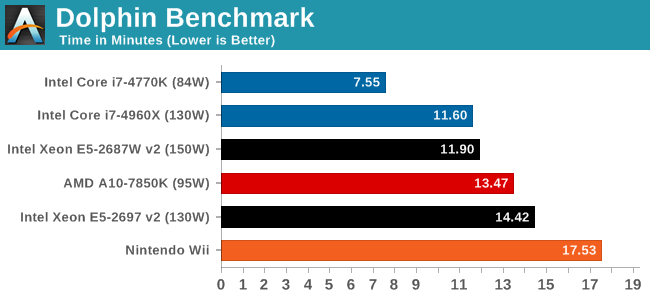
Emulation is a pure single threaded affair, and the IPC improvements of Haswell stand out a lot against the Ivy Bridge-E based Xeons.
Point Calculations – 3D Movement Algorithm Test: link
3DPM is a self-penned benchmark, taking basic 3D movement algorithms used in Brownian Motion simulations and testing them for speed. High floating point performance, MHz and IPC wins in the single thread version, whereas the multithread version has to handle the threads and loves more cores.
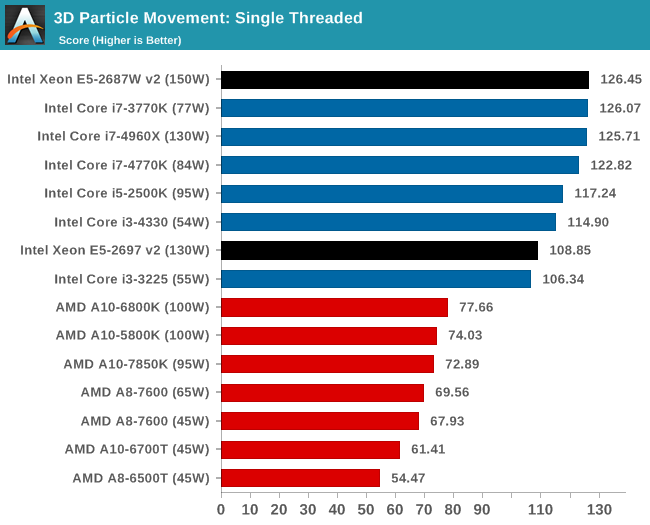
The low core frequency of the 12-core Xeon puts it behind in our FP single threaded benchmark.
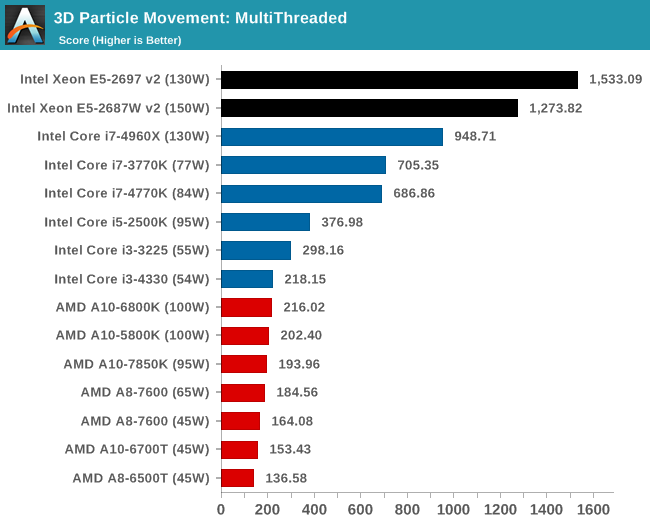
In out multithreaded scenario, we see the situation similar to PovRay, where cores and frequency take top spots.
Encryption –TrueCrypt v0.7.1a: link
TrueCrypt is an off the shelf open source encryption tool for files and folders. For our test we run the benchmark mode using a 1GB buffer and take the mean result from AES encryption.
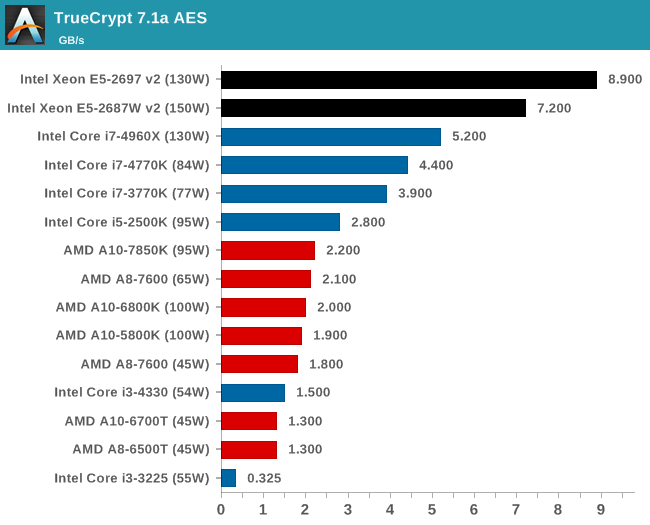
Synthetic – 7-Zip 9.2: link
As an open source compression tool, 7-Zip is a popular tool for making sets of files easier to handle and transfer. The software offers up its own benchmark, to which we report the result.
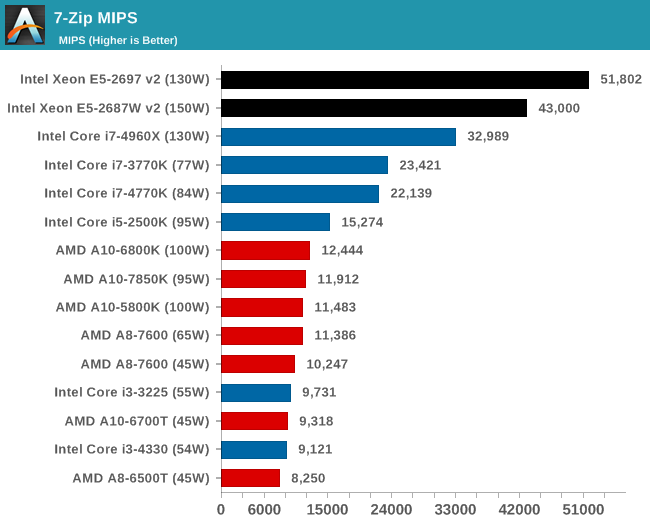










71 Comments
View All Comments
mrnuxi - Tuesday, March 18, 2014 - link
I know you were benchmarking these Xeons for home use, thus the selection of rendering and gaming benchmarks. But there are lots of us doing home virtualization (VMWare ESXi all-in-one servers using PCI-passthrough ZFS virtual SAN and multiple VMs). It would be great so see some virtualization benchmarks. For further reference see: http://www.napp-it.org/index_en.htmlIan Cutress - Tuesday, March 18, 2014 - link
Johan covered the server side in his article -http://www.anandtech.com/show/7285/intel-xeon-e5-2...
alpha754293 - Wednesday, March 19, 2014 - link
No LS-DYNA or other HPC benchmark results??? Talk to Johan.colonelclaw - Wednesday, March 19, 2014 - link
Hi Ian, Thanks for a great review.Do you think there's any possibility of adding V-Ray to your workstation benchmarks? It's an incredibly popular renderer that is multi-platform and also works in pretty much any decent 3D software (Max, Maya, C4D etc). It also sucks the life out of any computer when it's running, so would be perfect for your tests.
Kougar - Wednesday, March 19, 2014 - link
Question. Since you discuss turbo bins at length and the article revolves around them, how does Windows Server handle load balancing in regards to the turbo bins. On a 2P E5-2697 will the OS balance all the threads on a single CPU first? Spread evenly across both CPUs? Max out all physical cores before assigning threads to logical cores?Is the OS capable of spreading 3 threads to each processor to ensure they both run at the max turbo frequency for as long as possible? Or would it instead max out one processor to attempt to let the other retain a lower power state? For that matter is any of this even configurable under Windows Server?
Ytterbium - Saturday, May 3, 2014 - link
Ian, does MCE work with Xeon?Ytterbium - Tuesday, May 6, 2014 - link
MCE doesn't seem to work with Xeon 2687w.RadamanthysBe - Sunday, May 4, 2014 - link
Interresting article, but I dont agree with your conclusion on the 2667 vs 2687w :You say 2667 id cheaper, ok but 50 $ difference in list price on cpu costing 2100 $, that is less than 2%.
You also say 2687w v2 use more energy than 2667 v2, do you have proof of that ? For me the fact that 2687w v2 has a 150w tdp only mean it can keep its turbo frequency under higher load than 2667, with situations where 2667 turbo mode would drop because of the power usage while not on the 2687w v2, making it in fine a faster cpu than 2667 under heavy loads. If the two cpu run the same computation at the same frequency, there is no reason 2687w v2 uses more power, it would be like saying that i5 and i7 consume the same because they have the same tdp, while everybody knows it is not the case.
Ytterbium - Monday, May 5, 2014 - link
I just bought a 2687w v2, it ended up being $3 difference between them, I have i7-3970X so I have 150W chip anyway, so TDP wasn't really much of a factor to me.It would be interesting to do a head to head of them and see how they perform, in thermal load/power.
Following Ian's logic he's be super interested in the E5-2673 v2, this is the same as the 2667 but with 110W TDP.
If the 2690 had a little higher turbo, it would be great, 10/20 with say 3 stock and 3.8 turbo
Ytterbium - Tuesday, May 6, 2014 - link
The 2687 I got seems to run a bit cooler than my 3970X, even though there rated for the same.